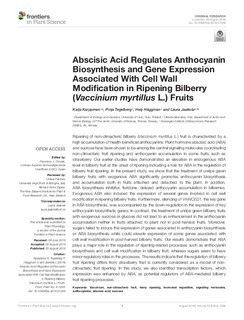| dc.contributor.author | Karppinen, Katja Hannele | |
| dc.contributor.author | Tegelberg, Pinja | |
| dc.contributor.author | Häggman, Hely | |
| dc.contributor.author | Jaakola, Laura | |
| dc.date.accessioned | 2018-11-06T11:43:34Z | |
| dc.date.available | 2018-11-06T11:43:34Z | |
| dc.date.created | 2018-10-23T14:24:18Z | |
| dc.date.issued | 2018-08-29 | |
| dc.identifier.citation | Frontiers in Plant Science. 2018, 9 . | nb_NO |
| dc.identifier.issn | 1664-462X | |
| dc.identifier.uri | http://hdl.handle.net/11250/2571233 | |
| dc.description.abstract | Ripening of non-climacteric bilberry (Vaccinium myrtillus L.) fruit is characterized by a high accumulation of health-beneficial anthocyanins. Plant hormone abscisic acid (ABA) and sucrose have been shown to be among the central signaling molecules coordinating non-climacteric fruit ripening and anthocyanin accumulation in some fruits such as strawberry. Our earlier studies have demonstrated an elevation in endogenous ABA level in bilberry fruit at the onset of ripening indicating a role for ABA in the regulation of bilberry fruit ripening. In the present study, we show that the treatment of unripe green bilberry fruits with exogenous ABA significantly promotes anthocyanin biosynthesis and accumulation both in fruits attached and detached to the plant. In addition, ABA biosynthesis inhibitor, fluridone, delayed anthocyanin accumulation in bilberries. Exogenous ABA also induced the expression of several genes involved in cell wall modification in ripening bilberry fruits. Furthermore, silencing of VmNCED1, the key gene in ABA biosynthesis, was accompanied by the down-regulation in the expression of key anthocyanin biosynthetic genes. In contrast, the treatment of unripe green bilberry fruits with exogenous sucrose or glucose did not lead to an enhancement in the anthocyanin accumulation neither in fruits attached to plant nor in post-harvest fruits. Moreover, sugars failed to induce the expression of genes associated in anthocyanin biosynthesis or ABA biosynthesis while could elevate expression of some genes associated with cell wall modification in post-harvest bilberry fruits. Our results demonstrate that ABA plays a major role in the regulation of ripening-related processes such as anthocyanin biosynthesis and cell wall modification in bilberry fruit, whereas sugars seem to have minor regulatory roles in the processes. The results indicate that the regulation of bilberry fruit ripening differs from strawberry that is currently considered as a model of nonclimacteric fruit ripening. In this study, we also identified transcription factors, which expression was enhanced by ABA, as potential regulators of ABA-mediated bilberry fruit ripening processes. | nb_NO |
| dc.language.iso | eng | nb_NO |
| dc.rights | Navngivelse 4.0 Internasjonal | * |
| dc.rights.uri | http://creativecommons.org/licenses/by/4.0/deed.no | * |
| dc.subject | Vaccinium | nb_NO |
| dc.subject | Non-climacteric fruit | nb_NO |
| dc.subject | Berry ripening | nb_NO |
| dc.subject | Hormonal regulation | nb_NO |
| dc.subject | Signaling molecules | nb_NO |
| dc.subject | Anthocyanins | nb_NO |
| dc.subject | Abscisic acid | nb_NO |
| dc.subject | Sucrose | nb_NO |
| dc.title | Abscisic acid regulates anthocyanin biosynthesis and gene expression associated with cell wall modification in ripening bilberry (vaccinium myrtillus l.) fruits | nb_NO |
| dc.type | Journal article | nb_NO |
| dc.type | Peer reviewed | nb_NO |
| dc.description.version | publishedVersion | nb_NO |
| dc.rights.holder | Copyright © 2018 Karppinen, Tegelberg, Häggman and Jaakola. | nb_NO |
| dc.subject.nsi | VDP::Landbruks- og Fiskerifag: 900 | nb_NO |
| dc.source.pagenumber | 17 | nb_NO |
| dc.source.volume | 9 | nb_NO |
| dc.source.journal | Frontiers in Plant Science | nb_NO |
| dc.identifier.doi | 10.3389/fpls.2018.01259 | |
| dc.identifier.cristin | 1622754 | |
| cristin.ispublished | true | |
| cristin.fulltext | original | |
| cristin.qualitycode | 1 | |

